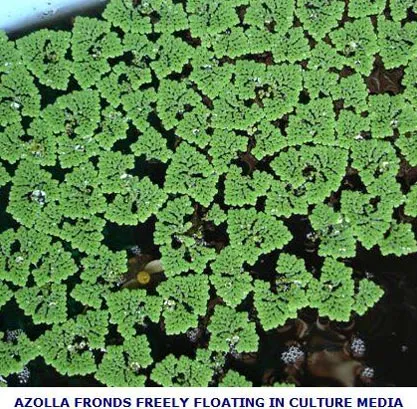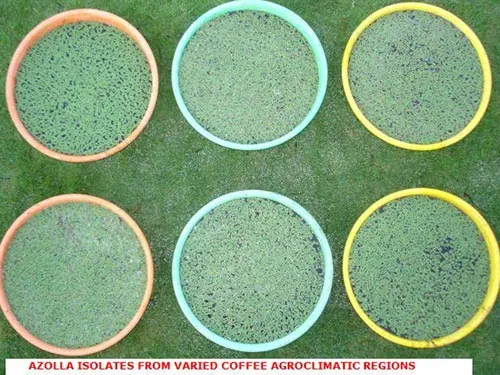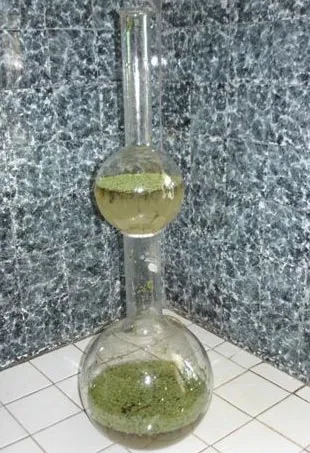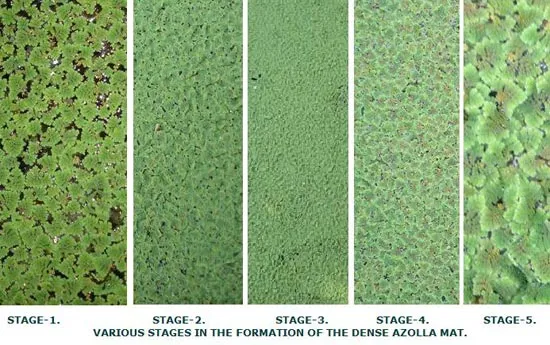by Dr. Anand Titus and Geeta N. Pereira
The coffee mountains are a picture’s place on planet earth. Panoramic scenery and ancient forts, steep green valleys and imposing peaks. Mountain tops painted with tall evergreen trees, shade the coffee plantations below. This describes Coffee County at its best. It is indeed a magical site.
The scenery is absolutely breathtaking. Hidden within the confines of these steep valleys are pockets of crystal clear springs and water holes which provide for the drinking needs of wildlife. A close look at some of these freshwater ecosystems and the trained eye can observe a few green colored ferns freely floating on the water surface. These ferns known as “AZOLLA “are natures gift to mankind in harvesting atmospheric nitrogen from the air.

From the standpoint of fertilizer management in coffee plantations, it would be very helpful to the coffee grower to realize the benefits of using azolla in supplying the partial nitrogen needs of coffee.
Azolla partners blue green algae inside its lobes and is capable of harvesting atmospheric nitrogen. Due to this invisible partnership the fern multiplies very fast. The symbiotic association of the algae aids in the creation of a huge amount of biomass on the surface of the water. It is then harvested, dried and used as biofertilizer to supplement the needs of nitrogen in coffee farms.
Since Azolla species are commonly found world wide in coffee producing countries, it could provide the coffee farmers with an inexpensive way of supplementing part of their nitrogen requirement, in an eco friendly manner, without polluting the environment.

The Elemental composition for Azolla on a dry weight basis.
%
NITROGEN
2.5-3.5
PHOSPHORUS
0.15-1.00
POTASSIUM
0.25-5.50
CALCIUM
0.45-1.25
MAGNESIUM
0.25-0.50
SULPHUR
0.20-0.75
SILICA
0.15-3.50
SODIUM
0.15-1.25
CHLORINE
0.50-0.75
ALUMINIUM
0.04-0.50
IRON
0.04-0.50
MANGANESE(ppm )
60-2500
COPPER(ppm )
2-250
ZINC(ppm )
25-750
Unfortunately, more than 90 % of the Indian coffee farmers are unaware of the beneficial aspects of using Azolla in augmenting nitrogen supplies and increasing coffee yields. The primary objective of this article is to enable coffee farmer’s world wide in realizing the benefits of using azolla either as fresh green manure or as an organic material in the preparation of compost.
Shade grown Indian coffee is grown on the slopes of mountains and the valleys are occupied by rice fields. Since, only one crop of rice is harvested, the same fields can be used to grow Azolla which can be later used as a rich source of compost material. Since the fern has a desirable carbon nitrogen ratio, it decomposes rapidly and can be used in a very short time. The fern also acts as a store house for potash accumulation and stores more than five times its requirement.
The significance of Azolla as a cheap source of nitrogen was first observed in China. The art of feeding the people ( Chih Min Tao Shu ), a book on agricultural techniques written in 540 A.D. by Jia Ssu Hsieh, describes the cultivation and use of azolla in rice fields. At the beginning of the 17th century, there were many local records of azolla use as manure both in China and Vietnam. Azolla plants have been described by the Chinese and Vietnamese as being miniature nitrogen fertilizer factories.
In coffee Country, the valleys play an important role in contributing towards the health of the coffee mountain. Different species of the fern are commonly found in different agro climatic conditions and the amount of nitrogen fixed also varies according to the species.

In the Azolla-Anabaena symbiosis, the fern is generally referred to as the macro symbiont and the blue green algae, namely anabaena is known as the microsymbiont. The two partners live in a very close relationship with one another. The fern provides the protection to the microsymbiont from oxygen damage from the external environment and the anabaena in turn provides the nitrogen to the fern for its growth and multiplication.
Both the partners harvest solar energy via photosynthesis and the total nitrogen requirement can be supplied by the assimilation of nitrogen fixed by anabaena, the microsymbiont ( Each leaf of azolla has the potential of harboring 75,000 Anabaena cells containing 3 to 3.5 % nitrogen ) . The beauty of this fern is that it is quite hardy and during favorable environmental conditions multiplies in geometric proportions. The algal symbiont is closely associated with all stages of the fern’s development. The symbiont resides in the cavities formed in the dorsal lobe of the fern. Rapid multiplication of the fern takes place in summer months.
World over there exist different species of Azolla. Azolla caroliniana, A. filiculoides, A. mexicana, A. microphylla, A. pinnata and A. nilotica. In India, A. pinnata is commonly observed. The algal symbiont belongs to the family Nostocaceae and is generally referred to as Anabaena azollae.

We have extensively worked with Azolla for over one decade collecting strains from different coffee growing regions and have analyzed the strains for their nitrogen fixing efficiency. Our observations point out to some very interesting facts. The amount of nitrogen, phosphorus and potassium content in azolla varies with variety, environment and field management. Different Varieties of Azolla species occur with the desired characteristics.
The field requirements of azolla and its nitrogen fixing symbiont, Anabaena azollae, for growth and nitrogen fixation are complex and strongly related to the biochemistry of each of the components of the association. For the survival of the partners, under adverse environmental conditions, the life cycle of both azolla as well as that of the algae is important.
MORPHOLOGY
The azolla fern is a freely floating fern with multi branches and long roots. Each leaf has two lobes, the ventral and dorsal lobes. The dorsal lobes are chlorophyllous and house the algal symbiont. The nitrogen fixing symbiont is present during all developmental stages of the fern. More importantly, the microsymbiont exhibits host specificity because no other algal species is found in the leaf cavities.
The fern appears lush green in color but turns orange red under stress conditions. This color comes from anthocyanin pigments.
PHYSIOLOGY
Air, light, water and mineral nutrients are important factors in determining the growth and development of the fern. A few scientists have worked on a variety of inorganic media to accelerate growth. Phosphorus and potassium are the major elements along with iron, molybdenum, cobalt.
pH: Our studies point out to the fact that most of the strains collected from coffee growing regions grow well in neutral pH. The optimum hydrogen ion concentration for Azolla species found in Joe’s sustainable farm is around neutral pH. Azolla species are also sensitive to high temperatures and the optimum temperature is between 25 and 30 degree centigrade.

LIGHT INTENSITY: Azolla grows well under semi shaded conditions. However, strong sunlight for a period of two to three hours is not detrimental for the growth and multiplication of the fern.
TEMPERATURE: The macro and micro symbiont exhibit growth over a relatively wide temperature range but the optimum range appears to be between 25 and 30 degree centigrade. Very high temperatures are unfavorable for vegetative growth of the fern.
PHOTOSYNTHESIS: The macro and the microsymbiont consist of photo synthetically active pigments. The light harvesting pigments of the individual partners are complementary. The azolla contains chlorophylls a and b while the alga contains chlorophyll a and phycobilins. Both partners contain carotenoids.
NITROGEN FIXATION: The atmospheric nitrogen is harvested by the algal symbiont. Heterocysts are the sites of nitrogen fixation. Heterocyst frequency increases along the stem from apex to base in the successive leaves.
SURVIVAL: The sporocarps produced by azolla can endure long periods of desiccation. Under natural conditions proliferation of azolla is entirely through vegetative reproduction. However, Sexual reproduction, which is essential to the survival of the population during temporary adverse conditions, also occurs. A combination of favorable environmental conditions favors the germination of spores.
WATER TURBULENCE: Plant density and turbulence of the water surface markedly influences growth rate and nitrogenase activity of the fronds.
DOUBLING TIME: Under favorable conditions the fern multiplies in geometric proportions and doubles in three to four days with an average nitrogen content of 3%.
EFFECT OF HERBICIDES and PESTICIDES: Our observations point out to the fact that the presence of azolla is more markedly reduced in intensive crop management than in traditional zones where sustainable agriculture is practiced. Herbicides and pesticides have a deleterious effect on the occurrence of Azolla.
JOE’S SUSTAINABLE FARM and THE USE OF AZOLLA

Azolla that is cultivated in rice fields is allowed to form a dense mat. The green azolla is allowed to slowly turn red, by reducing the water level in the field. This reddish brown azolla is allowed to dry in the field itself. Once dry it is turned into the soil and the entire mixture is then added to compost pits or simply broadcasted inside the coffee farm. This practice results in the increase in soil organic matter and triggers the growth and multiplication of beneficial microbes.
In the second method, fresh azolla is harvested from ponds and fields and used in the preparation of compost. Since the fern has an excellent carbon nitrogen ratio it decomposes rapidly and accelerates the decomposition of other organic residues inside the compost pit.

In the third method, freshly harvested azolla is directly broadcasted at the base of the coffee plant and incorporated with scuffle digging.
MULTIPLE USES OF AZOLLA

The potential uses of azolla are numerous. Azolla is a nutrient rich fern and has traditionally been used throughout Asia and parts of Africa as feed for livestock, poultry and fish. Azolla contains very high levels of protein and fat and promotes the development of both grain production and stock breeding. In some countries the fern is used for ornamental purposes. At times azolla is also used as human food.
Chemical Analysis of Azolla on a dry weight basis.
% on dry matter basis.
ASH
10.00
CRUDE FAT
3.0-3.5
CRUDE PROTEIN
20-25
SOLUBLE SUGARS
3.0-3.5
STARCH
6.0-6.5
CHLOROPHYLL-A
0.25-0.50
RECOMMENDATIONS FOR RESEARCH
- Establishment of azolla germplasm collection in coffee growing regions.
- Characterization of various azolla isolates should be undertaken so as to determine their nitrogen fixing efficiency.
- Package of practices for azolla production should be standardized.

- Development of techniques for the germination of azolla spores.
- Since various azolla cultures are present in various agro climatic coffee regions, we need to develop techniques for the differentiation of Anabaena azollae strains.
CONCLUSION
From time immemorial, farmers all over the world have used compost, green manures and other organic residues as a major source of nitrogen to promote plant growth and increase crop production. In recent years commercial fertilizers have supplied the bulk of the coffee industry’s fertilizer needs. Both economic and environmental considerations strongly favor biological nitrogen fixation as the process of choice in the future.
Azolla has the potential of supplying part of the nitrogen requirement of coffee through biological means. In approximately 75 days, a hectare of azolla can produce three layers of green manure. The value of this amounts to 25 kg nitrogen per hectare. The azolla can be harvested and either incorporated into soil or used in the preparation of compost.
We have interviewed a number of second generation and third generation farmers from coffee growing regions and they are of the opinion that the farming community in the early 1930’s and 1960’s were familiar with the use of azolla as a green manure. However, with the discovery of synthetic fertilizers, the fern slowly lost its prominence. They also point out to its present disappearance from its natural environs due to the indiscriminate use of herbicides, pesticides and weedicides. Unfortunately, today, the fern is present in only a few pockets and needs to be carefully nurtured like an endangered species.
We are confident that in the coming years, the combined efforts of scientists and planners will stimulate the interest of coffee farmers, in the use of azolla as an ecofriendly, biofertilizer in supplying the nitrogen needs of coffee.
REFERENCES
Anand Titus Pereira. 1984. Multiplication of Azolla isolates in soils of Karnataka. Thesis submitted to the University of Agricultural Sciences, Bangalore for the award of the Degree of Master of Science in Agricultural Microbiology.
Anand Titus Pereira and Shetty. K.S. 1987. Physiological properties and response to different levels of phosphorus by four azolla isolates. Seventh Southern Regional conference on Microbial Inoculants . U.A.S. Bangalore.
Anand Titus Pereira and Shetty. K.S. 1987. Studies on the morphological and physiological characteristics of five azolla isolates [ Azolla pinnata ]. Seventh Southern Regional conference on Microbial Inoculants . U.A.S. Bangalore.
Anand Titus Pereira and Shetty. K.S. 1987. Effect of pesticides on the growth and nitrogen fixation of Bidadi isolate of Azolla pinnata. Seventh Southern Regional conference on Microbial Inoculants . U.A.S. Bangalore.
Anand Titus Pereira & Gowda. T.K.S . 1987. Hydrogen supported Di Nitrogen fixation in bacteria associated with wetland rice endorhizosphere. International Symposium and workshop on Biological Nitrogen Fixation associated with rice production. Central Rice research Institute, Cuttack, India.
Anand Titus Pereira & Gowda. T.K.S. 1991. Occurrence and distribution of hydrogen dependent chemolithotrophic nitrogen fixing bacteria in the endorhizosphere of wetland rice varieties grown under different Agroclimatic Regions of Karnataka. (Eds. Dutta.S.K. and Charles Sloger.U.S.A.) In Biological Nitrogen Fixation Associated with Rice production. Oxford and I.B.H. Publishing.Co. Pvt. Ltd. India.
Alexander ,M. 1974 . Microbial Ecology. New York. John Wiley and sons.
Alexander ,M. 1977 . Introduction to soil Microbiology. 2nd edition. New York. John Wiley and sons.
Atlas, R.M. and R. Bartha. 1993. Microbial Ecology : Fundamentals and application. Third edition. Benjamin/Cummings Pub. Co. New York.
Brock. T. D. 1979. Biology of Microorganisms. Third Edition. Englewood Cliffs. Prentice-Hall.
Kotpal ,R.L. and N.P. Bali. 2003. Concepts of Ecology. : Environmental and field biology. Vishal Publishing Company.India.
Killham. K . 1994. Soil Ecology. Cambridge University Press, Cambridge. England.
Paul. E.A. and Clark. F. E. 1996. Soil Microbiology and Biochemistry. Academic Press.
Jiaa Sy Spier. 6th century A.D. Chi Min Yao Shu.
Michelle and Jude Fanton. 1990. Azolla-fertilizer, mulcher and weed suppressant. 1990. International Permaculture JournaL. 35. March-May.
Peters. G.A., Mayne. B.C., Ray.T.B. and R.E. Toia. Jr. 1979. Physiology and Biochemistry of Azolla- Anabaena symbiosis. In Nitrogen and Rice. International Rice Research Institute. Philippines.
Bio-fertilizers for Coffee Plantations
Organic Matter Decomposition In Coffee Plantations
The Fine Art of Composting In Coffee Plantations
Role of Bacteria in Coffee Plantation Ecology
Role of Fungi in Coffee Plantation Ecology
The Importance of Neem For Sustainable Coffee Production
The Role of Actinomycetes in Coffee Plantation Ecology
Nitrogen Economy Inside Coffee Plantations